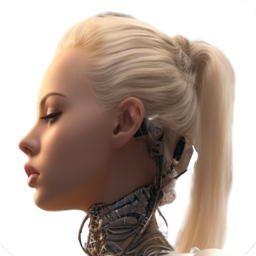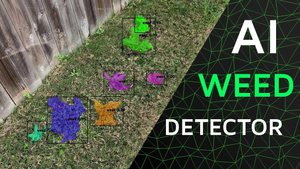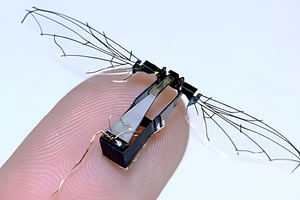In the gentle rustle of leaves and the lowing of cattle, the age-old dance of farming continues to unfold. A practice as ancient as human civilization itself, animal farming has been the cornerstone of sustenance and survival, deeply rooted in tradition and the rhythmic cycles of nature. Yet, as the dawn breaks on a new era, a mechanical hum mingles with the chorus of the farm, heralding a revolution that is quietly reshaping the landscape of animal care.
The advent of robotics in agriculture is more than a mere technological advancement; it's a philosophical crossroads where the tactile wisdom of the ages meets the precision and efficiency of the machine. Farming, once synonymous with the human touch, the intuition born of generations, is now being augmented and, in some aspects, redefined by robotic systems. From automated milking parlors to intelligent feeding mechanisms, the robotic age is not merely knocking at the barn door but has already entered, silently transforming the daily routines of both farmer and beast.
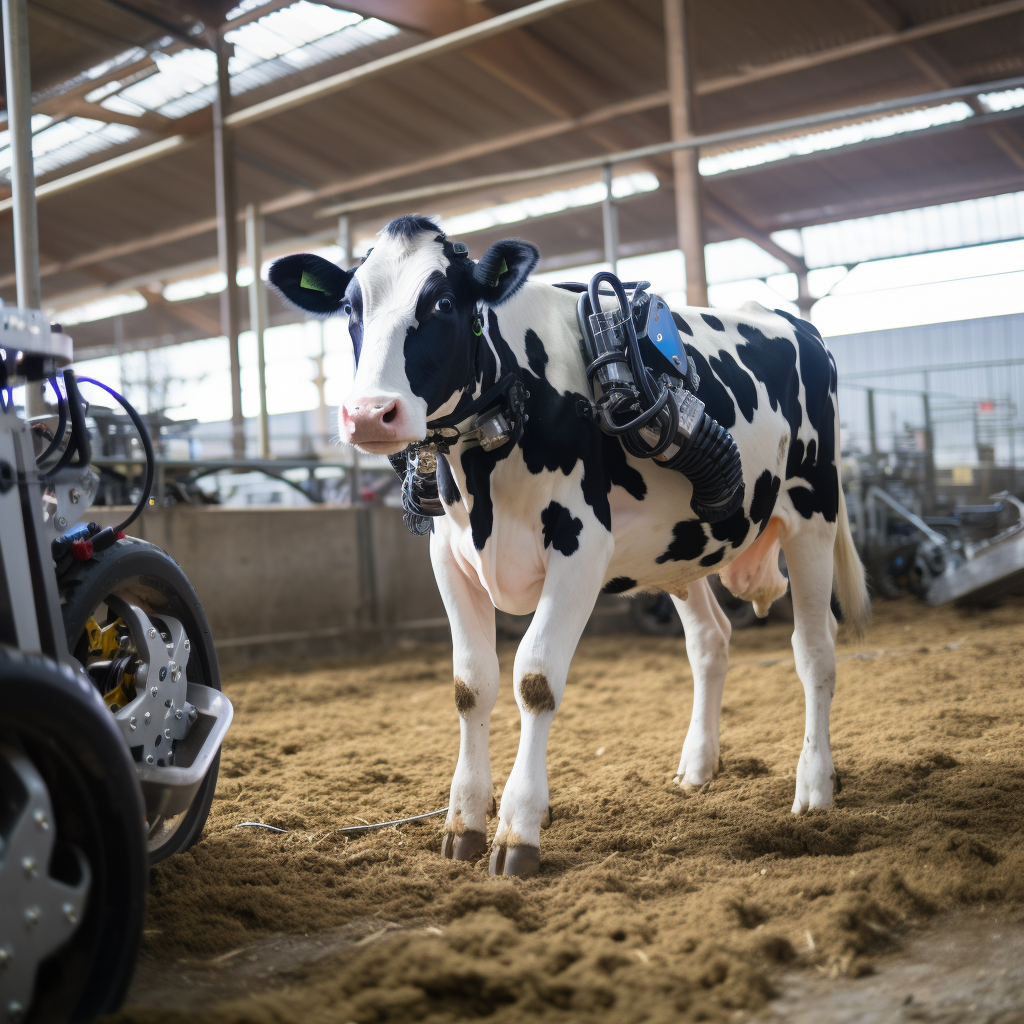
But what does this convergence mean for the very essence of farming? How does one reconcile the warmth of tradition with the cold efficiency of technology? Is there a middle ground where tech meets farming without losing the soul of animal care? These questions are not mere musings of a futuristic novel but pressing inquiries that demand exploration as we stand on the cusp of a new age.
In this journey through pastures and silicon, we will explore how robotics revolutionizes animal care in modern farming practices. We will explore the key advancements that are enhancing efficiency and welfare, unravel the ethical considerations, celebrate the success stories, and ponder the future of animal care in the robotic age. Along the way, we will grapple with the complex interplay of human emotion, ethical responsibility, and technological innovation, seeking to understand how we can balance technology with humanity in this delicate dance of life.
As we embark on this exploration, we are left to ponder: In an age where machines can mimic the human hand, can they also replicate the human heart?
Robotics at the Helm of a New Era - Key Advancements and Innovations
In the past, farmers relied on keen observation and intuition to monitor the well-being of their livestock. Today, Precision Livestock Farming (PLF) has brought a new level of accuracy to this task. Utilizing sensors, cameras, and intelligent algorithms, PLF systems can track an animal's weight, temperature, movement, and even its eating habits. This creates a digital portrait of the individual creature, enabling farmers to detect subtle changes that might indicate a health issue. The profound question this raises is: Are we entering an age where technology not only observes but understands the silent language of animals?
PLF
Precision Livestock Farming (PLF) is an approach to animal farming that uses information technology and a wide range of items such as GPS guidance, control systems, sensors, robotics, drones, autonomous vehicles, variable rate technology, GPS-based soil sampling, and automated hardware to optimize field-level management with regard to livestock farming.
Here's a quick summary:
Monitoring: PLF involves continuous real-time monitoring of individual animals or groups to understand their health, development, and well-being. This can include tracking vital signs, behavior, and other indicators.
Data Analysis: By collecting and analyzing data, farmers can make more informed decisions. This can lead to better animal welfare, increased productivity, and more efficient use of resources.
Automation: PLF often involves the automation of routine tasks such as feeding, milking, or cleaning. This saves labor and can be done with precision to meet each animal's individual needs.
Sustainability: By optimizing feed, water, and energy use, PLF can contribute to more sustainable farming practices. It helps in reducing waste and minimizing the environmental impact.
Health Management: Early detection of health issues is possible through continuous monitoring, allowing for timely intervention and treatment. This can reduce the need for antibiotics and other medications.
Economic Benefits: Though it requires an initial investment in technology, PLF can lead to cost savings in the long run through optimized resource use and increased productivity.
Challenges: Implementation of PLF can be complex and requires a combination of technological expertise, animal husbandry knowledge, and data management skills. Privacy and security of data are also concerns.
In summary, Precision Livestock Farming represents a modern, technology-driven approach to livestock management that emphasizes data-driven decision-making, automation, and sustainability. It holds the potential to revolutionize the livestock industry but also presents challenges that must be carefully managed.
Automated Milking Systems (AMS): The Art of Milking Reimagined
Milk, the symbol of nourishment and nurturing, has been drawn by human hands for millennia. Now, robotic arms have taken up this task, guided by lasers and sensors. Automated Milking Systems (AMS) allow cows to be milked at their leisure, reducing stress and improving milk quality. Yet, this transformation leads us to reflect: Does the mechanization of such an intimate process alter our relationship with the very products that sustain us?
Intelligent Feeding Robots: A Tailored Diet for Every Animal
Beyond mere sustenance, food plays a vital role in an animal's growth, development, and overall well-being. Intelligent feeding robots can now customize diets for individual animals based on specific needs and preferences. They recognize each animal, dispensing the right amount of feed with the right nutritional balance. This raises the philosophical inquiry: In striving for efficiency, are we also nurturing a more profound understanding of individuality within the animal kingdom?
Drones and Aerial Surveillance: The Eye in the Sky
Farmers once walked their fields, a practice imbued with a sense of connection to the land and its inhabitants. Now, drones equipped with advanced imaging technology offer a bird's-eye view of entire farms. They monitor grazing patterns, detect signs of disease, and even keep watch for predators. The historical connection here is palpable, as we move from the ground to the sky, from human eye to mechanical eye. What does this shift signify for our connection to the land and the creatures we care for?
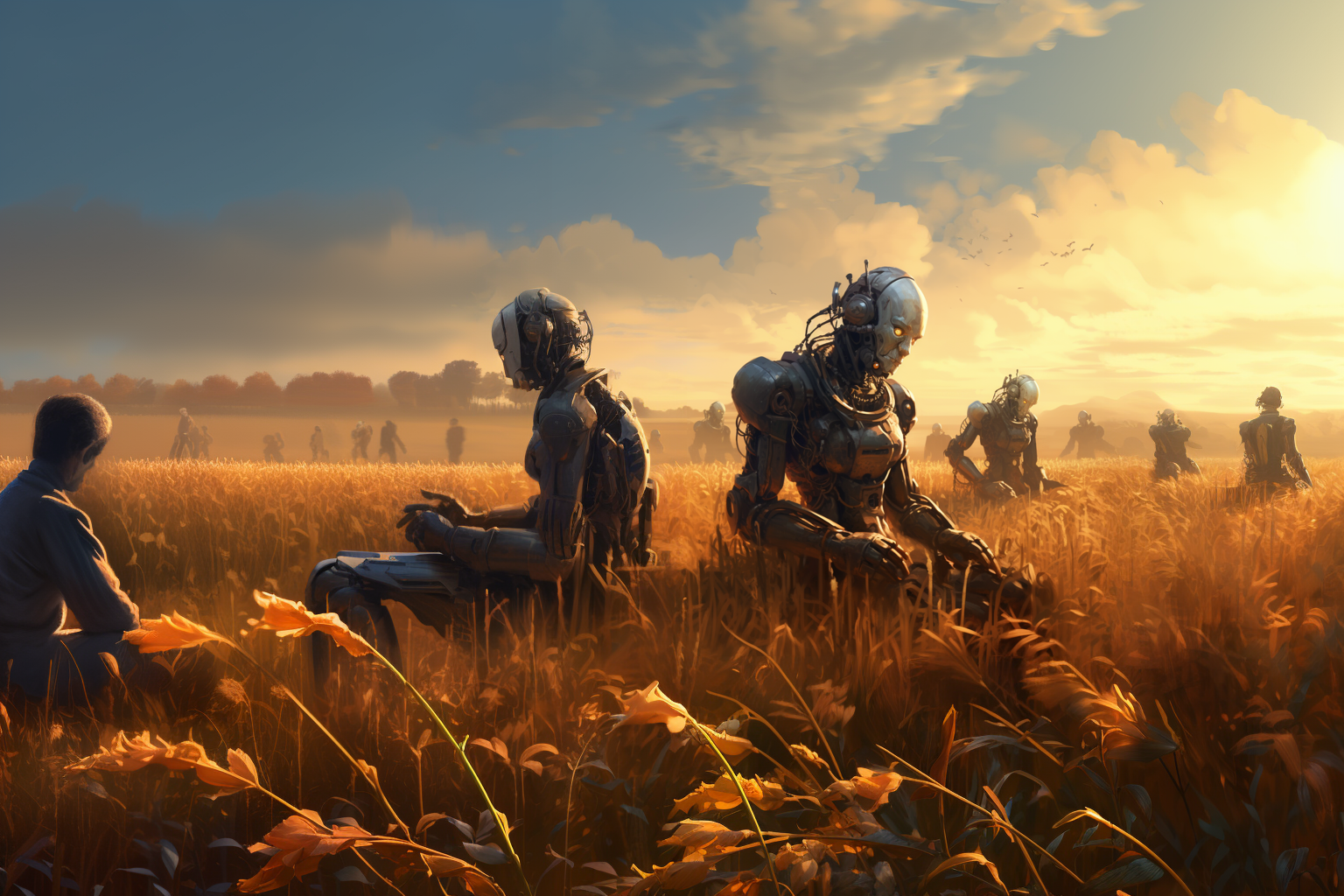
Robotic Shepherds: Guiding the Flock
Robotic shepherds, guided by AI and GPS, now assist in herding animals, ensuring their safety, and managing pasture rotation. This technological marvel provokes a cultural insight: The shepherd, a timeless symbol of guidance and protection, has been a central figure in our myths and religions. How does the emergence of a robotic shepherd reshape this ancient narrative, and what does it tell us about our evolving relationship with technology?
The integration of robotics into animal care is not merely a step forward in efficiency and productivity; it's a leap into a new realm of understanding, empathy, and connection. These advancements echo a broader trend in our relationship with technology, where machines are no longer mere tools but collaborators, interpreters, and even, in some sense, companions.
Yet, as we marvel at these innovations, we must also pause to reflect on the ethical considerations, the balance between machine precision and human compassion, and the profound questions they raise about our place in this interconnected web of life. How do we navigate this new landscape without losing sight of the values, traditions, and connections that define our humanity?
The dawn of the robotic age in animal farming is both a challenge and an opportunity, a complex tapestry where tech meets tradition. As we move forward, we carry the responsibility to ensure that this technological symphony resonates not just with the logic of efficiency but with the melody of empathy and care.
Bridging Traditions and Technology – Sustainability and the Harmony of Animal Care
As global demands for food grow, the urgency to cultivate sustainable practices within animal farming becomes paramount. With its precision and efficiency, robotics offers a pathway to balance productivity with environmental stewardship. Automated systems optimize resource usage, reducing waste and lowering energy consumption. Yet, the ethical dilemma looms: How do we ensure that our pursuit of sustainability through technology does not overshadow the inherent value of nature and its living beings?
Enhanced Welfare through Intelligent Monitoring: Understanding without Intrusion
Animal welfare, once reliant on the watchful eye of the farmer, is now augmented by intelligent monitoring systems. Sensors and AI algorithms detect animal discomfort, illness, or injury, allowing for timely intervention. The philosophical question here is profound: Can a machine's unobtrusive gaze foster a new kind of intimacy with the creatures it monitors, enhancing understanding without infringing on their autonomy?

Robotic Integration with Traditional Practices: The Symphony of Old and New
The fusion of robotics with traditional farming practices creates a harmonious blend where technology amplifies rather than replaces human expertise. Tools like robotic shepherds or intelligent feeding systems work in tandem with farmers, preserving the wisdom of generations while embracing innovation. This integration provokes a historical connection: How has the blend of tradition and technology shaped human progress before, and what lessons can we draw from those experiences?
The Global Impact of Robotics in Farming: Equity, Accessibility, and the Dream of a Better World
Robotics is not a privilege confined to affluent societies; it's a tool with the potential to democratize animal care and farming practices across the globe. By making precision and efficiency accessible, robotics can help small-scale farmers compete, bridging gaps in technology and knowledge. But the ethical consideration remains: How do we ensure that the benefits of robotics reach all corners of the globe, contributing to global health equity without exacerbating existing inequalities?
5. The Future of Farming in the Robotic Age: A Vision, A Responsibility
As we stand on the cusp of a new era where robots are integral to animal care, we must reflect on the vision we hold for the future. The blending of high-tech robotics with the earthy wisdom of traditional farming paints a picture of a world where technology serves life, efficiency meets empathy, and innovation is in harmony with heritage. Yet, we must also recognize this vision's responsibility and the need to navigate the complex interplay of ethics, technology, emotion, and ecology.
Animal Care in the Robotic Age is not merely a story of machines and algorithms; it's a narrative of human ingenuity, ethical reflection, and a deep connection to the living world. It's a dance where technology and tradition move in step, creating a future that honors the past while embracing the possibilities of the present.
As we ponder this intricate dance, we must ask ourselves: What does it mean to care in an age of machines? How do we forge a future where technology enhances rather than erodes our connection to the living world? And most importantly, how do we ensure that this future is one where the melody of empathy, ethics, and enlightenment resonates in every beat of progress?
Section III: Ethical Frontiers, Success Stories, and Gazing into the Future
1. Ethical Compass: Navigating the Morality of Machine Care
In an era where machines can feed, monitor, and even simulate affection towards animals, ethical frontiers are being redrawn. Is there a risk of losing something profoundly human when care becomes automated? How do we define compassion and responsibility in the context of algorithm-driven care? These are not mere philosophical musings but guideposts for a responsible journey into uncharted technological territories.
2. Success Stories: Farms Where Technology Blooms with Life
Across the globe, farms are living proof of the promise robotics holds. From robotic milking systems in Switzerland to intelligent poultry monitoring in Japan, technology is enhancing both productivity and animal well-being. These success stories serve as lighthouses, guiding others towards a harmonious integration of tradition and innovation. They also pose a question: What is the secret alchemy that turns technology into a nurturing force?
3. Challenges and Hurdles: The Road to Robotic Harmony
The path to a future where robotics and animal care coexist is fraught with challenges. The cost of technology, the need for specialized skills, and potential resistance from traditional farming communities are real barriers. How do we democratize access to these technologies? How do we foster a culture of innovation without alienation? The answers lie in a delicate balance of education, empathy, and engagement.
4. Global Health Equity and Accessibility: A Dream Within Reach
The utilization of robotics in animal care is not a pursuit confined to the developed world. It’s a global endeavor with the potential to revolutionize food security and healthcare. But how do we ensure that these advancements don’t widen the gap between the technological haves and have-nots? The pursuit of global equity in animal care technology is not just a logistical challenge; it's a moral imperative.
5. The Future Awaits: Preparing Farmers for a New Dawn
The future of animal care in the robotic age is a tapestry woven with threads of opportunity, responsibility, and creativity. But how do we prepare farmers and the industry for this transformation? Continuous education, collaboration between tech developers and farming communities, and policies that nurture innovation without neglecting heritage are key. The historical connection is clear: Every technological revolution required foresight, adaptability, and a commitment to human values.
Conclusion: A Symphony of Questions, A Horizon of Hope
The exploration of animal care in the robotic age is a symphony filled with questions, ethical considerations, real-world success stories, and glimpses into a hopeful future. It's a narrative that resonates with the complexity of human innovation and the timeless values of compassion and stewardship.
As we stand on the brink of this new era, we are invited to reflect: How do we ensure that our pursuit of efficiency does not compromise empathy? How do we write a future where technology is a partner, not a replacement, in caring for the living world? How do we craft a tomorrow where robotics becomes a tool for nurturing, not just optimizing?
The answers to these questions will shape not only the future of farming but reflect our collective wisdom, ethics, and humanity as we venture into a world where technology and life dance to a new rhythm.
Conclusion: A Journey of Discovery, A Canvas of Questions
Animal Care in the Robotic Age is a journey of discovery that transcends the boundaries of science, ethics, culture, and philosophy. It's a canvas painted with questions, challenges, innovations, and hopes. It's a story that we are all part of, as we ponder the role of technology in nurturing life.
What does it mean to care in an age of algorithms? How do we forge a future where technology amplifies our humanity rather than diminishes it? How do we navigate the delicate dance between innovation and integrity?
These are not just questions for farmers, technologists, or policymakers. They are inquiries for all of us, as we stand at the intersection of what we create and who we are.
The Harmonious Symphony of Technology and Care
As we stand at the crossroads of animal care and robotic technology, it's imperative to recognize that this is not a path towards dehumanization but rather a pursuit of a more compassionate and responsive form of care. How can we ensure that the very technology that empowers us also embodies our values and our humanity?
The application of robotics in animal care ushers in an era that demands ethical stewardship. What guiding principles will shape the responsible integration of technology in farming? How can we cultivate an ethical framework that honors the dignity of both animals and humans?
The robotic revolution in animal care is a global phenomenon, but it's not a monolithic one. Different cultures, societies, and individuals bring unique perspectives and values. How can we foster a dialogue that embraces this diversity and creates a harmonious dance between technology and tradition?
The exploration of robotics in animal care is not a static picture but a living tapestry, continually woven with new questions, insights, challenges, and opportunities. It's a dynamic field that invites ongoing curiosity, learning, and growth. How will we continue to evolve, learn, and adapt in this ever-changing landscape?
In the end, the journey of integrating robotics into animal care is a mirror reflecting our collective soul. It's an exploration of who we are, what we value, what we hope for, and what we fear. It's a story that transcends technology and reaches into the core of our shared human experience. How will we write this story together, and what legacy will we leave for future generations?

Epilogue: A Call to Thoughtful Engagement
The fusion of robotics and animal care is more than a technological feat; it's a philosophical inquiry, an ethical challenge, a cultural dance, and a human journey. It's an invitation to engage thoughtfully, empathetically, and creatively with the world around us.
How will you respond to this call? How will you contribute to this unfolding story? How will you navigate the beautiful complexity of a world where tech meets farming, where innovation meets compassion, and where the future meets the present?
These are questions without definitive answers, inquiries that beckon us to ponder, explore, and create. They are an invitation to all of us to be not merely spectators but active participants in shaping a future where technology is not an end but a means, a tool guided by our deepest values and our shared humanity.


